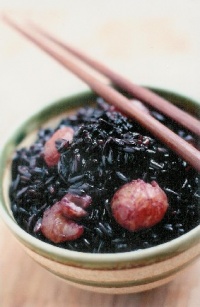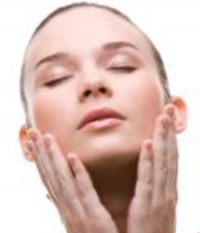 |
For most cultures across the globe, there are beauty constants such as clear skin, bright eyes, and shiny hair. Like calmness and strength, these outward features are universally attractive. While we work towards these qualities with regimens that may include exercise, meditation, or even using a nice shampoo, the foods we eat are key to achieving inner and outer beauty.
In traditional Chinese medicine, foods are prescribed for their effects on organs, blood, yin, yang, and Qi, the major players in our physical and emotional health. Foods such as rice, seaweed, sweet potatoes, and bananas nourish our yin, which in turn hydrates and nourishes organs. Think of a parched plant; after a good watering it becomes more tumescent. Eating yin-enhancing foods nourishes the body in a way that simple drinking water cannot.
Sweet black rice, when cooked with longan berries (euphoria longana) and Chinese dates, becomes a congee that nourishes blood and Qi. In the Chinese system of food cures, these three foods work together to enhance beauty and longevity.
- The sweet rice promotes the flow of liver Qi, which helps keep angry feelings at bay and leads to calmness.
- The Chinese dates (different from the Mediterranean variety) nourish blood and spleen, promoting restful sleep and mental clarity.
- Longan fruit, a blood enhancer, was used by the ancients to add luster to the skin. From a Western perspective, we know that longans contain large amounts of Vitamin C and phenolic compounds, which may help to detoxify and protect the liver.
Sweet Rice Congee
(Taken from Ancient Healing for Modern Women, by Dr. Xiolan Zhao, C.M.D.)
Ingredients:
1 cup black sweet rice (wash before using)
½ cup dried longan fruit
10 Chinese dates
2 tablespoons raw sugar
½ inch piece of fresh ginger, peeled and thinly sliced
Instructions:
In a large heavy saucepan, add 6 cups of water, black sweet rice, longan fruit, dates, and raw sugar. Bring to a boil over medium heat. Reduce heat and simmer for two hours, stirring occasionally. Garnish with ginger. Makes four servings.
Note: All ingredients are available at most Asian grocery stores.

 Acupuncture and Oriental medicine can be very effective at treating skin conditions. Treatments can provide quick relief for acute symptoms and significant and lasting relief from recurrent or chronic skin conditions.
Acupuncture and Oriental medicine can be very effective at treating skin conditions. Treatments can provide quick relief for acute symptoms and significant and lasting relief from recurrent or chronic skin conditions.
 Repetitive stress injuries (RSI) are the most common job-related injuries and are responsible for the highest number of days lost among all work related injuries. One of the most well-known types of repetitive stress injury, carpal tunnel syndrome (CTS) accounts for over two million visits to physicians’ offices and approximately 465,000 carpal tunnel release operations each year, making it the most frequent surgery of the hand and wrist.
Repetitive stress injuries (RSI) are the most common job-related injuries and are responsible for the highest number of days lost among all work related injuries. One of the most well-known types of repetitive stress injury, carpal tunnel syndrome (CTS) accounts for over two million visits to physicians’ offices and approximately 465,000 carpal tunnel release operations each year, making it the most frequent surgery of the hand and wrist. Patients suffering TMJ (temporomandibular joint disorder) can find relief from acupuncture. Research conducted at the Ribeirão Preto Dental School, São Paulo University in Brazil, found that after 3 months of acupuncture, patients with TMJ experienced significantly less pain, increased strength of their bite and decreased EMG activity of the masticatory muscles.
Patients suffering TMJ (temporomandibular joint disorder) can find relief from acupuncture. Research conducted at the Ribeirão Preto Dental School, São Paulo University in Brazil, found that after 3 months of acupuncture, patients with TMJ experienced significantly less pain, increased strength of their bite and decreased EMG activity of the masticatory muscles. More than 45 million Americans (one in six) suffer from chronic headaches, 20 million of whom are women. Scientific research shows that acupuncture can be more effective than medication in reducing the severity and frequency of chronic headaches.
More than 45 million Americans (one in six) suffer from chronic headaches, 20 million of whom are women. Scientific research shows that acupuncture can be more effective than medication in reducing the severity and frequency of chronic headaches.

